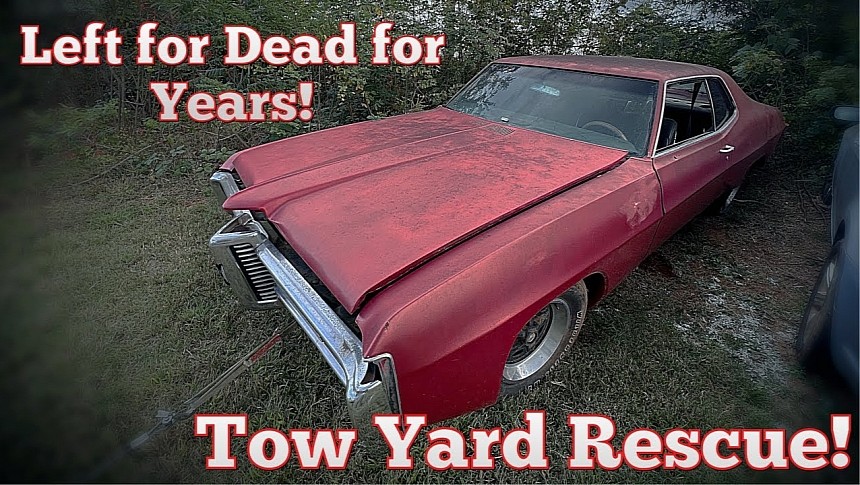When it came around in 1953, the Corvette sparked a chaos-theory fire that rippled through space and time for decades. Initially, the idea wasn’t countered by anyone in Detroit, but 1955 marked the debut of the Ford Thunderbird. This two-door two-seater had its cake and ate Chevrolet’s. Cunningly, FoMoCo played the ‘not-another-sports-car’ card, and it didn’t last long before everyone else followed suit. On behalf of Pontiac Motor Division, the spearhead was the Grand Prix, launched in 1962 as a full-size ‘personal luxury’ automobile.
The Thunderbird beat the Corvette (badly) at the two-seat game. Still, it downright buried it when the Blue Oval switched to the ‘more-passenger’ paradigm. The T-Bird (mockingly called the Thunder Chicken) never looked back at its roots, and the rest of Detroit had to admit temporary defeat.
Soon, everyone was playing ‘catch’ running after the Thunderbird and trying to bite deep into its market-share pie. For General Motors, Pontiac opened the offensive with the full-size Grand Prix of 1962. Until the end of the 1968 model year production, the lush Pontiac sat on the same platform, and sales went on a rollercoaster trend. From the 73,000-unit high-water mark of 1963 to the alarmingly disappointing results of 1968 (just over 31,000).
The Grand Prix 1968 was a disaster – for bean counters – and one man pointed out a possible culprit. Bill Collins was, at the time, John DeLorean’s right hand. Together with Rus Gee, head of the Experimental Department, the two men planned and executed the GTO in 1964. As assistant chief engineer responsible for body production at Pontiac, Collins retrospectively analyzed the downfall of Pontiac full-size personal luxury cars. "Our 1968 Grand Prix was a disaster. Nobody bought it. It looked like a big fat turkey . . ." The hidden headlamps were retained, in combination with a rather garish full-width eggcrate grille.”
All the features that the Pontiac executive lined up on the suspect's list were carried over from 1967, a year of significant change for the Grand Prix, style- and engine-wise. First, the familiar stacked headlights disappeared, making way for horizontal adjacent round lamps hidden beyond a pair of covers that imitated the grille.
The ’68 didn’t change much overall, but the details made much difference. The beak-nose protruded outward considerably, and the taillights ditched the louvered styling in favor of a more streamlined, L-shaped, narrow set of lamps. At the business end, the choices were limited to the standard 400-cubic-inch, 350-hp /355 PS V8 (Pontiac’s famous 6.6-liter) or a pair of 428 inchers (7.0-liter), tuned for either 375 or 390 hp (380, 395 PS).
Unlike everyone else in Detroit, Pontiac couldn’t be bothered with casting small and big block engines – they used a one-size-fits-all lump, fiddling with the bore and stroke to get from 265 cubes to the mighty 455-cubic-inch (from 4.3 liters to 7.5 liters, respectively). The main difference was the main journal diameters (3.25 inches on the 421/428/455 V8 and 3.0 inches on the 400 and below).
That’s how the Pontiac trinity (DeLorean-Collins-Gee) from the early sixties was able to effortlessly drop a 389-cube V8 (6.4-liter) in the Tempest, ultimately triggering a motoring revolution and paving the way for the muscle car fashion. 1967, the 389 was refreshed and bored to 400 cubic inches (6.6 liters). Similarly, the 421-CID advanced in ranks to 428 cu-in (7.0 liters).
Both engines were available in the Grand Prix and continued in the last year of the full-size GP. However, regardless of their displacement, Pontiac sprayed its engines with light blue. Something a past owner of the 1968 Grand Prix in the video from Budget Buildz YouTube Channel certainly disagreed with and put a fresh coat of Chevrolet orange on the V8.
The car’s history is vague, but we know it sat for a long while – and the interior shows severe signs of neglect. The outside is solid and straight, with no rust or other corroding defects, but there is something not right with the car. Namely, its V8 – a replacement 400 cu-in from 1972 (four years after the vehicle was assembled).
The loosely-mounted carburetor is not Pontiac (the PMD Q-Jets were center fill), but its low-ranking GM sister division. Whoever rebuilt the motor probably loved to see the USA but didn’t have the Chevrolet to do it. Fifty-five years after its first crank, the Pontiac is being salvaged and brought back to road life, courtesy of the vloggers with an appetite for classic projects.
While it sat for a long time, the engine isn’t in bad shape at all, but its water pump is; luckily, with such a generous amount of engine bay volume, putting a new one in it isn’t a knuckle-buster. To stay on the safe side, the sparkplugs are also replaced, along with the alternator. After correctly wiring the plugs according to their respective firing order, the V8 runs nice and smooth again. Well, as soft as an old engine with a long pause can run.
The fresh oil certainly helped – the old lubricant was slowly turning into jelly – but the primary headache was the transmission. The sifting quadrant and the gearbox strongly disagree: with the lever in reverse, the car moves forward - and the other way around. Since the YouTubers don’t provide any information about this car’s original configuration, we can’t say what engine it has (400 or 428 – and, if the latter were the case, which tune).
But irrespective of their sizes, the Pontiac V8s of the era were prone to one common failure – the nylon timing gear tended to lose its teeth. Alternatively, the chain was pretty much gone around 100,000 miles (161,000 km). Again, the vastness of the front-end bay allowed for a reasonably easy job of fitting a nice double roller set.
The derelict cabin was once a sumptuous accommodation for its occupants, with air conditioning, bucket seats, and a console shifter for the Turbo Hydra-Matic three-speed automatic. At one point, an owner decided the original steering wheel wasn’t appealing enough and put an aftermarket piece instead. Still, as far as build goes, we’ve seen some curious cases of mixing components from other makes – take a look at this Buick GSX tribute that’s a Skylark with a Chevy 454.
Soon, everyone was playing ‘catch’ running after the Thunderbird and trying to bite deep into its market-share pie. For General Motors, Pontiac opened the offensive with the full-size Grand Prix of 1962. Until the end of the 1968 model year production, the lush Pontiac sat on the same platform, and sales went on a rollercoaster trend. From the 73,000-unit high-water mark of 1963 to the alarmingly disappointing results of 1968 (just over 31,000).
The Grand Prix 1968 was a disaster – for bean counters – and one man pointed out a possible culprit. Bill Collins was, at the time, John DeLorean’s right hand. Together with Rus Gee, head of the Experimental Department, the two men planned and executed the GTO in 1964. As assistant chief engineer responsible for body production at Pontiac, Collins retrospectively analyzed the downfall of Pontiac full-size personal luxury cars. "Our 1968 Grand Prix was a disaster. Nobody bought it. It looked like a big fat turkey . . ." The hidden headlamps were retained, in combination with a rather garish full-width eggcrate grille.”
All the features that the Pontiac executive lined up on the suspect's list were carried over from 1967, a year of significant change for the Grand Prix, style- and engine-wise. First, the familiar stacked headlights disappeared, making way for horizontal adjacent round lamps hidden beyond a pair of covers that imitated the grille.
Unlike everyone else in Detroit, Pontiac couldn’t be bothered with casting small and big block engines – they used a one-size-fits-all lump, fiddling with the bore and stroke to get from 265 cubes to the mighty 455-cubic-inch (from 4.3 liters to 7.5 liters, respectively). The main difference was the main journal diameters (3.25 inches on the 421/428/455 V8 and 3.0 inches on the 400 and below).
That’s how the Pontiac trinity (DeLorean-Collins-Gee) from the early sixties was able to effortlessly drop a 389-cube V8 (6.4-liter) in the Tempest, ultimately triggering a motoring revolution and paving the way for the muscle car fashion. 1967, the 389 was refreshed and bored to 400 cubic inches (6.6 liters). Similarly, the 421-CID advanced in ranks to 428 cu-in (7.0 liters).
Both engines were available in the Grand Prix and continued in the last year of the full-size GP. However, regardless of their displacement, Pontiac sprayed its engines with light blue. Something a past owner of the 1968 Grand Prix in the video from Budget Buildz YouTube Channel certainly disagreed with and put a fresh coat of Chevrolet orange on the V8.
The loosely-mounted carburetor is not Pontiac (the PMD Q-Jets were center fill), but its low-ranking GM sister division. Whoever rebuilt the motor probably loved to see the USA but didn’t have the Chevrolet to do it. Fifty-five years after its first crank, the Pontiac is being salvaged and brought back to road life, courtesy of the vloggers with an appetite for classic projects.
While it sat for a long time, the engine isn’t in bad shape at all, but its water pump is; luckily, with such a generous amount of engine bay volume, putting a new one in it isn’t a knuckle-buster. To stay on the safe side, the sparkplugs are also replaced, along with the alternator. After correctly wiring the plugs according to their respective firing order, the V8 runs nice and smooth again. Well, as soft as an old engine with a long pause can run.
The fresh oil certainly helped – the old lubricant was slowly turning into jelly – but the primary headache was the transmission. The sifting quadrant and the gearbox strongly disagree: with the lever in reverse, the car moves forward - and the other way around. Since the YouTubers don’t provide any information about this car’s original configuration, we can’t say what engine it has (400 or 428 – and, if the latter were the case, which tune).
The derelict cabin was once a sumptuous accommodation for its occupants, with air conditioning, bucket seats, and a console shifter for the Turbo Hydra-Matic three-speed automatic. At one point, an owner decided the original steering wheel wasn’t appealing enough and put an aftermarket piece instead. Still, as far as build goes, we’ve seen some curious cases of mixing components from other makes – take a look at this Buick GSX tribute that’s a Skylark with a Chevy 454.



























